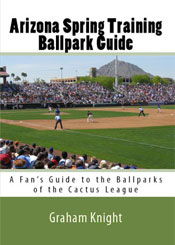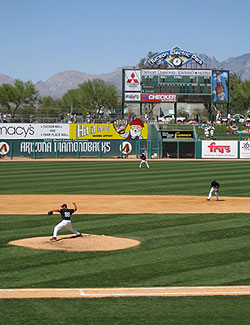
|
Of all the ballparks in the Cactus League, Tucson Electric Park feels the most different. That’s because it’s a hybrid between the intimate spring training parks of the past and the modern minor league ballparks that have been built over the past decade.
That compromise was necessary because Tucson Electric Park, or TEP for short, is the only ballpark in Arizona that was designed to serve a dual purpose. Home to the White Sox and Diamondbacks in spring training, TEP hosts the Tucson Sidewinders of the Triple-A Pacific Coast League in the five months following March. As such, it’s the only ballpark in the Cactus League to be used for regular season games after the spring exhibitions end. That consideration was taken into account when TEP was designed, with the goal of building a ballpark that was suitable for both spring training fans and the locals who come to watch minor league ball in the summer. That explains the large number of suites, party decks and tents within the confines of TEP, many of which go unused during the spring schedule of games that the ballpark hosts. Groups have their choice of two upper deck terraces, a pair of tents in left field, and the Chill & Grill Station in right field. The first of its kind in the Cactus League, the Chill & Grill serves all-you-can-eat ballpark food for $20 per person to groups of 20 or more. To help groups find their designated party areas, a Today’s Picnic Locations whiteboard was placed outside of the ballpark, which has two entrances. Fans can enter through turnstiles in right field or behind home plate, the latter of which was designed to be the main entrance. A curved, desert colored wall that was added for aesthetic reasons beckons fans to the home plate entrance, but otherwise the ballpark’s exterior is forgettable.
In addition to the memorable mountain views, the ballpark has a pair of unique design features. Starting with the one-of-a-kind, a walkway accessible solely for vendors was built between the seats and concourse. The walkway is noticeable because of the blue rail roof that covers it. Fans stand behind the handrails that prevent them from entering the narrow passageway to take advantage of the shade the roof offers. Separation is also what makes TEP’s other design feature so unique, as the ballpark’s upper level is behind the concourse, not above it. The upper deck houses the press box and eight sections of suites, plus another eight sections of covered mezzanine seating, which are the only seats in the ballpark available to the public that offer shade. Fans not willing to pay the top dollar ticket price to sit in the covered mezzanine should bring their sunscreen, as all sections in the upper level are restricted to ticket holders only. TEP has the two features that are becoming traditional at modern ballparks – a wide concourse that wraps around the stadium and a grass berm in the outfield. The expansive berm at TEP covers the entire outfield, narrowing only behind the bullpens, and goes inside of the left field foul pole, finally ending where the grandstand begins. The sole scoreboard in the ballpark is behind the berm in left-center and features an electronically operated line score, but no video board. TEP has a multitude of seating options. Fans not choosing lawn seating or the upper covered mezzanine can sit in the large lower-level grandstand, which consists primarily of green colored stadium seats but also has bleacher style benches down both lines. Two sections of traditional bleachers – the metallic kind without seat backs – have been set up on the concourse down the left field line. Fans can even choose to get glimpses of the action for free thanks to a pedestrian bridge that crosses over the highway and provides a bird’s eye view of the field from behind left-center. If not for the hitter’s backdrop, the view of the playing field would be unobstructed. The bridge is not necessary – it’s rarely used – but does provide another focal point outside of the ballpark. Although it doesn’t have the same vibe as its Cactus League brethren, the “Pride of Pima County” is a satisfactory place to watch a ballgame, made memorable by its outstanding setting.
Update As a result of these developments, the Diamondbacks could very well leave too. And that would leave Tucson Electric Park without any tenants. A decision by the D-backs should come soon, but with team president Derrick Hall saying "it was our intent early on to stay here, but we made it clear that we need at least four teams [training in Tucson] for it to work out," it looks like the ballpark will encounter a trifecta of team abandonment.
Location and ParkingLocated southeast of downtown, Tucson Electric Park is the centerpiece of the 155 acre Kino Sports Complex. The complex has a dozen baseball fields and two half-fields, plus three soccer fields and two youth softball fields. The only other development in the nearby vicinity is the UPH Hospital, which is just beyond right field. The ballpark is a very short distance from Interstate 10, which is visible from the parking lot. Parking is abundant and costs $5. There are the 3,330 spaces (1,000 paved; 2,300 gravel or grass), all located between the ballpark and I-10.

Tucson Electric Park Facts, Figures & Footnotes
| |||||||||||||||||||||||||



 What fans attending a game at TEP won’t forget is the sweeping vistas of the Catalina Mountains, which can be seen anywhere from inside or outside of the ballpark. In a state noted for its mountain landscapes, most ballparks in Arizona take advantage of their majestic presence but none do a better job than TEP.
What fans attending a game at TEP won’t forget is the sweeping vistas of the Catalina Mountains, which can be seen anywhere from inside or outside of the ballpark. In a state noted for its mountain landscapes, most ballparks in Arizona take advantage of their majestic presence but none do a better job than TEP.
